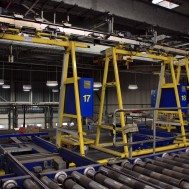The automation of industry at this point is indisputable, and there is certainly a case to be made for both sides. Use of industrial robots in manufacturing may optimize efficiency, but some debate the decrease in human control robots cause will have its own drawbacks.
The autonomous robot market itself is forecasted to be worth more than $11,920 million globally by the year 2024, making its dominance seem likely on both a financial and logical level.
Following a New Year’s Resolution to increase employee value to the industry means remaining educated on the advantages and disadvantages of current trends, regardless of personal opinion. Here are both sides of the debate about the use of industrial robots in manufacturing:
Advantages
- Cost-effectiveness is one of the most sound arguments to be made for the case of industrial robots. Robots will reduce production costs by eliminating internal costs to compensate human salaries. Businesses are forecasting that their profitability will increase once they implement robots into production, or that they will have more financial mobility to invest in new products or technologies.
- Quality assurance is expected with the use of machinery in production. Industrial robots will be able to ensure consistency with mass production of manufactured products. The possible human error that assembly line workers pose the threat of will be removed.
- Optimized production efficiency means that a general manager will be able to have set quantity and quality standards that will be met by robots. Production quotas will not be jeopardized by low concentration, break time and employee injuries, among other things. The efficiency of production forecasts and supply levels will be increased with robots, able to be programmed to work at the optimal speed for a given plant.
- Limiting human work in hazardous environments, because manufacturing jobs often place workers at more physical risk compared to a lot of other industries. Lowering the level of a hazard presented to employees on the job is attractive to executives to preserve company reputation and minimize potential legal liabilities. Riskier industries like manufacturing and mining, who have notorious disasters like that of the Upper Big Branch Mine, look to robots for their ability to replace unskilled workers doing necessary jobs in hazardous environments.
Disadvantages
- Job loss is by far the most significant opposition frequently brought against the use of robots in the manufacturing industry. Industry workers of all levels, from entry-level to veterans, worry about the security of their employment status, and the ability of their job to be replaced by a robot. This panic is more widespread in this industry compared to others because of the closer immanence of a robot takeover in manufacturing.
- Macro effects are another topic that usually comes up with job loss. More “big picture” thinkers wonder how the national, and eventually global economy will be affected when manufacturing workers’ jobs are displaced. How can this mass unemployment possibly be compensated for, and how can the robots’ presumed success be limited from seeping into other industries? CNN offered an incredibly poignant parallel, saying that horses to cars are what human workers are to robots. The horse population peaked in the US about a century ago since they were the main form of transportation. But these numbers have steadily declined ever since cars hit the mainstream. Jobs that do not require as much human analytical thought are more vulnerable because they are easier for machines to handle, with the replacement of EZ Pass toll operators being a good example.
- Increased investment costs are a financial counterpoint to industrial robots, with the idea that manufacturing companies will rack up their debt investing in robotic technology. Firms that do not have the funding might even go bankrupt in an effort to keep up with industry trends rather than continue on with normalized operations.
- Elimination of a whole labor class would presumably occur a bit of a ways down the road, but the implications of this point are too large not to consider. Bringing in robots to take unskilled labor jobs will place more pressure on the economy, education system, and financial market, just to name a few. The United States has always been associated with the grit and work ethic of its blue-collar workers, and robots are threatening to eliminate this aspect of the human population, with a take over of production jobs.
What’s your take on the pros and cons of using industrial robots in manufacturing? Tweet us @AppleRubber to continue the conversation.
